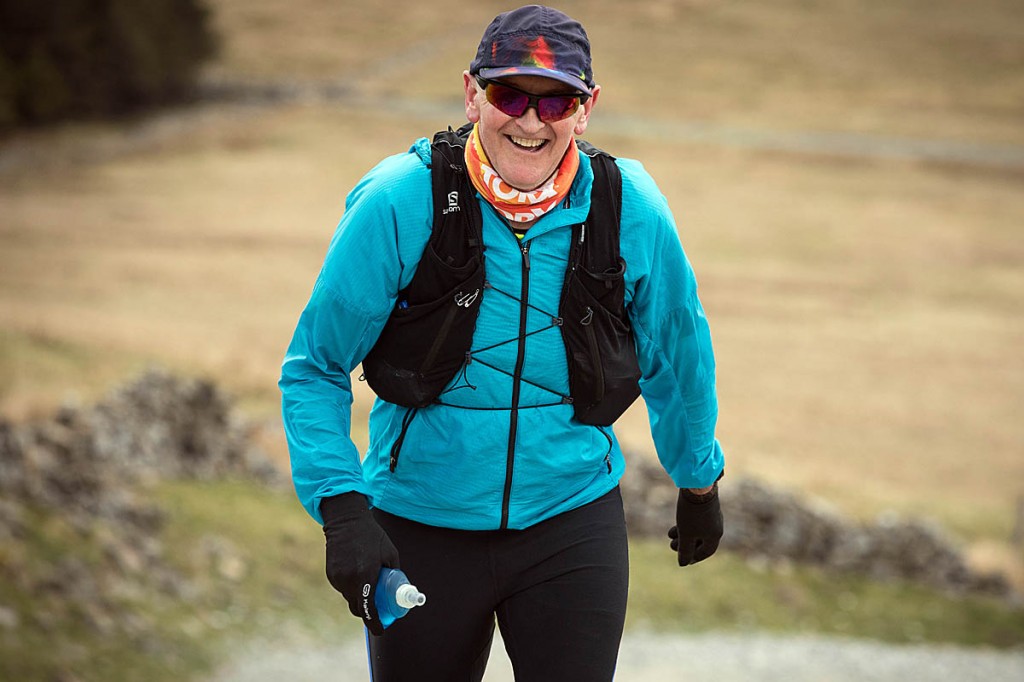
Brian Melia at Kidstones above Cray during his successful continuous run of A Pennine Journey. Photo: Bob Smith/grough
For 47 years a record of a man’s solitary walk on the spine of northern England lay unread by all except his closest acquaintances.
Alfred Wainwright’s account of his exploration of the countryside between Yorkshire and Hadrian’s Wall gathered dust while his reputation as an author and fellwalking authority grew.
A Pennine Journey, written after the 31-year-old municipal treasurer’s footslog as the storm clouds of war gathered over Europe, was finally published in 1986 and gave a glimpse into the state of the North of England at the time as well as an insight into the sometimes troubling psyche of the man who would become one of the most celebrated walking guidebook authors of the 20th century.
Long-distance walking enthusiast David Pitt and his wife Heather, both Wainwright aficionados, eyed up the 1938 route with a view to turning it into a walking trail fit for the 21st century and, with the help of fellow members of the Wainwright Society, devised a long-distance walk that started and ended at Settle, at the southern border of the Yorkshire Dales national park, heading north to Hadrian’s Wall along the eastern Pennine flanks and returning down the western side of the chain.
Mainly eschewing sections of metalled road used by Wainwright in a pre-war Britain largely devoid of motor traffic, the Pitts linked rights of way to devise a 247-mile (398km) route suitable for walkers, 36 miles longer than the author’s original journey.
The walk was undertaken, in sections, by West Yorkshire woman Susan Melia, who described it to her husband Brian as one of the best she had experienced. And she planted in him the germ of an idea that came to fruition on Tuesday when he became the first known person to complete A Pennine Journey in a continuous run.
The 56-year-old optometrist from Ilkley arrived back at Settle railway station just after 10.15pm, 3 days 16hrs 16mins 58 secs after setting out.
During his challenge, he barely slept, encountered waist-deep bogs, a May blizzard, but also the support and companionship of his family and friends, many from the Gritstone Club mountaineering organisation.
Speaking after he had run into the record books, Melia said: “It was the right thing to do. After talking to Susan, I was umming and ahing – should I do it?
“Susan was the instigator. She bought a book in 1986 for her parents and later on the modification of the route by David and Heather Pitt and over the next 10 years Susan walked it. She said it was one of the favourite walks she’d ever done so she said: why don’t you run it? That’s how it started.”
Remarkably, over the near 3¾ days on the hoof, Melia only slept about four hours. He skipped one planned rest because of worsening weather, and relied rather on cat-naps. “We set off on Saturday at six and I was trying to get to Rookhope about one or two in the morning and get a few hours’ sleep,” he told me.
“We came in at five and got a couple of hours sleep. I was up at seven. The next morning I was trying to get over Cross Fell before the bad weather came in, so I cancelled my sleep on Sunday morning. Last night I had five or ten minutes.”
Inevitably, this led to the hallucinatory phenomenon known to endurance athletes as sleep monsters. “I had a few hallucinations, but nothing nasty. The peacocks were quite good.”
He was meticulous to the point of annoyance to some of his support runners in following the exact course of the waymarked route. “When I spoke to David and Heather Pitt, who wrote the book, I asked them whether they would mind me running it following their GPX files and also what’s on the OS maps. I didn’t want to upset them.
“They were thrilled and we’re also trying to open it up to fellrunning as well as walkers, so I think it was a good idea to do that. I probably was too exact because, in some situations you see this line going across a bog or something or a difficult section and it wasn’t the right thing to do, but at the same time you’ve got people following you and I didn’t want it to be null and void. It’s also got a history.
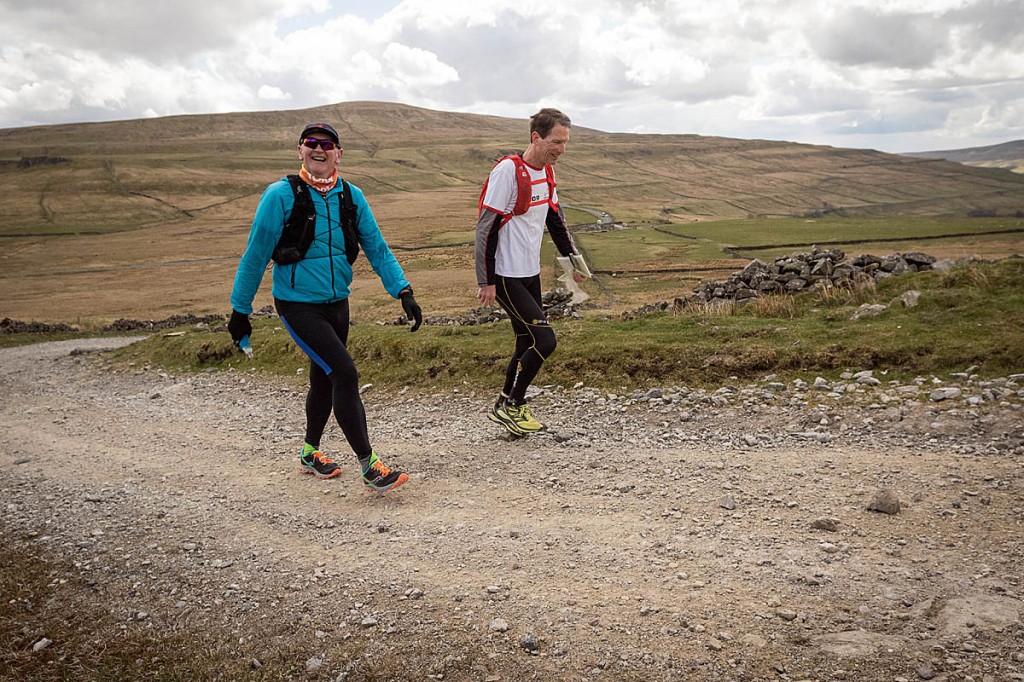
Brian Melia, left, with support runner Roy Ruddle, whom he described as an excellente navigator. Photo: Bob Smith/grough
“When I was running round and rehearsing the route, I found it very strange by the Moorcock Inn and we went north and I was thinking why this way, because the weather was so foul? Obviously, through the night it was very difficult too.”
That section included his least favourite stretch of A Pennine Journey. Melia said: “The best bit was probably from Gunnerside up to Tan Hill and the worst bit from the Moorcock near Garsdale Head to Fell End near the Cross Keys.
“Obviously, the Cross Keys and that area are lovely, but going back a bit was very difficult, energy sapping.”
The challenge was very much a home-spun affair, with no big sponsors and with support coming from family, including his wife Susan and son Richard, and several running buddies and fellow members of the Gritstone Club. In total he had 14 runners helping him, plus three support drivers on the road.
The run began in benign weather but conditions deteriorated seriously during the second day and into the third, with the final peak, Ingleborough, summited in blizzard and whiteout conditions.
“The weather when I saw you at Yockenthwaite, it was just stunning; it was just one of the most fabulous days,” he said.
“I was worried it was going to be too hot but actually it was pretty good as we went north. I was expecting rain on Sunday morning but it didn’t transpire until later on. I think we went over Cross Fell about one or two o’clock. When we got up there we went into Greg’s Hut. Richard had prepared us a special coffee and some food.”
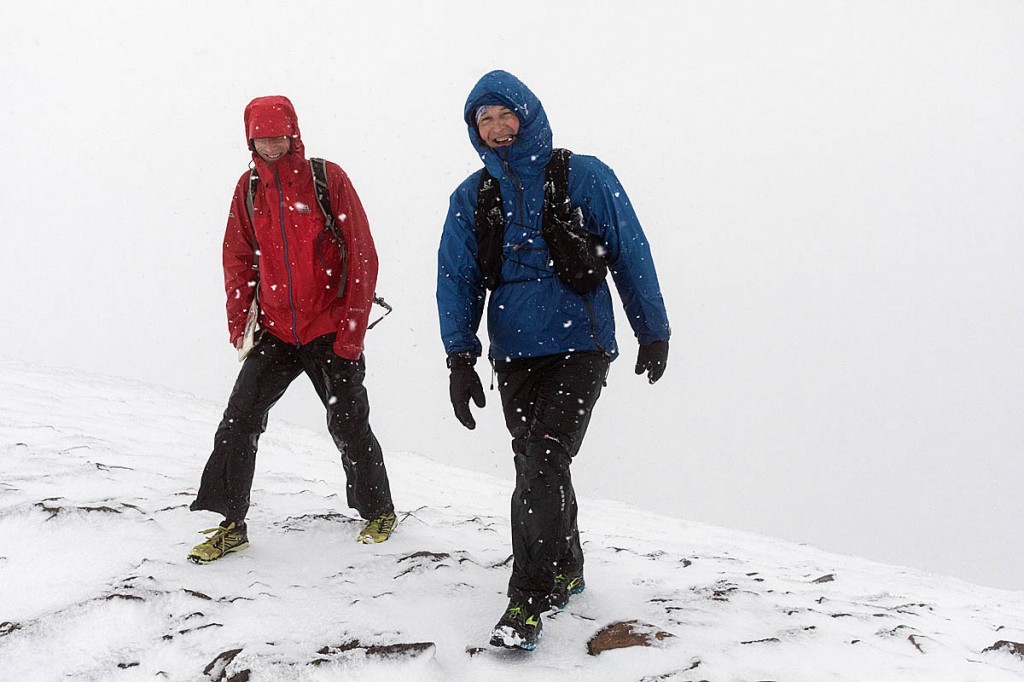
Brian Melia, right, with Roy Ruddle on the summit of Ingleborough in blizzard condtions. Photo: Bob Smith/grough
Being properly equipped helped him get through the conditions, he said. “I dealt with the really bad weather by having good gear. My team, and Richard in particular, looked after my feet and changed my socks every time there was a 20-mile section.
“I was really careful; I had good advice, used moisturiser.”
Susan Melia added: “Richard read a lot of articles on foot management and he was doing that on every stop. Richard’s really proud of his feet.”
Though when I spoke to Brian on Saturday he admitted his toes had subsequently ballooned ‘like uncooked sausages’ on the days after he completed the run.
Clothing was key too, he said: “I layered a lot; I had full waterproofs, with my Páramo, which was my go-to for bad weather.”
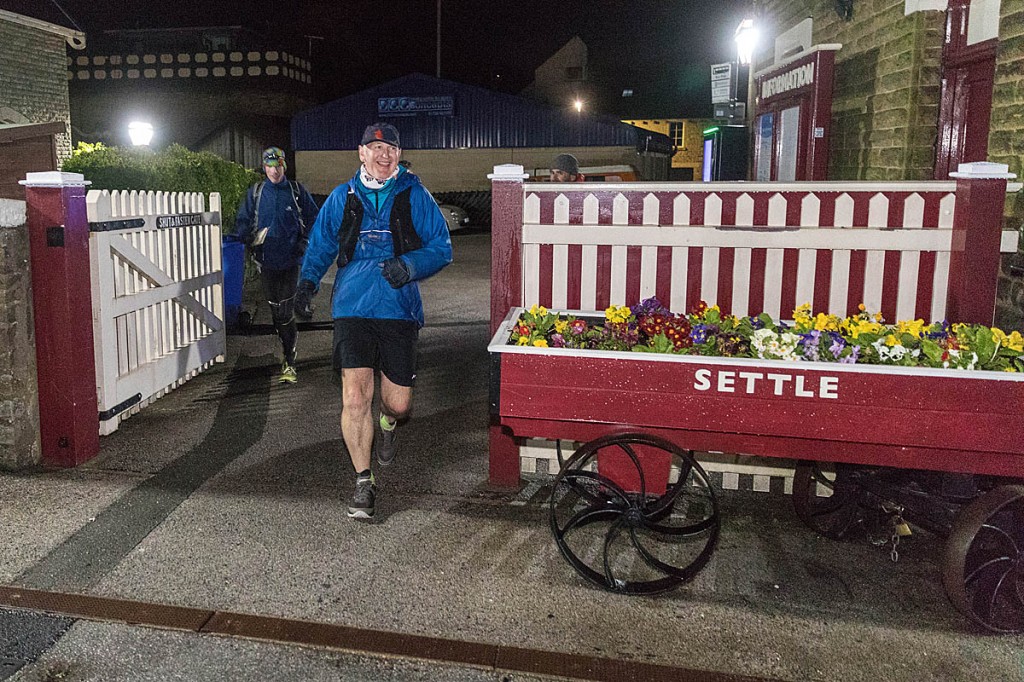
Brian Melia arrives at Settle railway station at the end of his successful continuous run of A Pennine Journey. Photo: Bob Smith/grough
Brian Melia is now recuperating and trying to decide whether he is in a good enough state to act as a support runner for another athlete’s planned record bid at the weekend.
He is also minded to have a crack at another long-standing endurance record, he revealed.
Quite what Wainwright would have made of Melia’s feat is probably best left unpondered. But, having posted a fastest known time for the route opens the possibility that others will now set out to better his record.
They too will then be able to say, as Wainwright did at the conclusion of A Pennine Journey: ‘I came into Settle a giant, and all around were staring pygmies’.
- The challenge has been submitted to the Fastest Known Time website.
- Brian Melia’s journey track can be seen on the Open Tracking website.
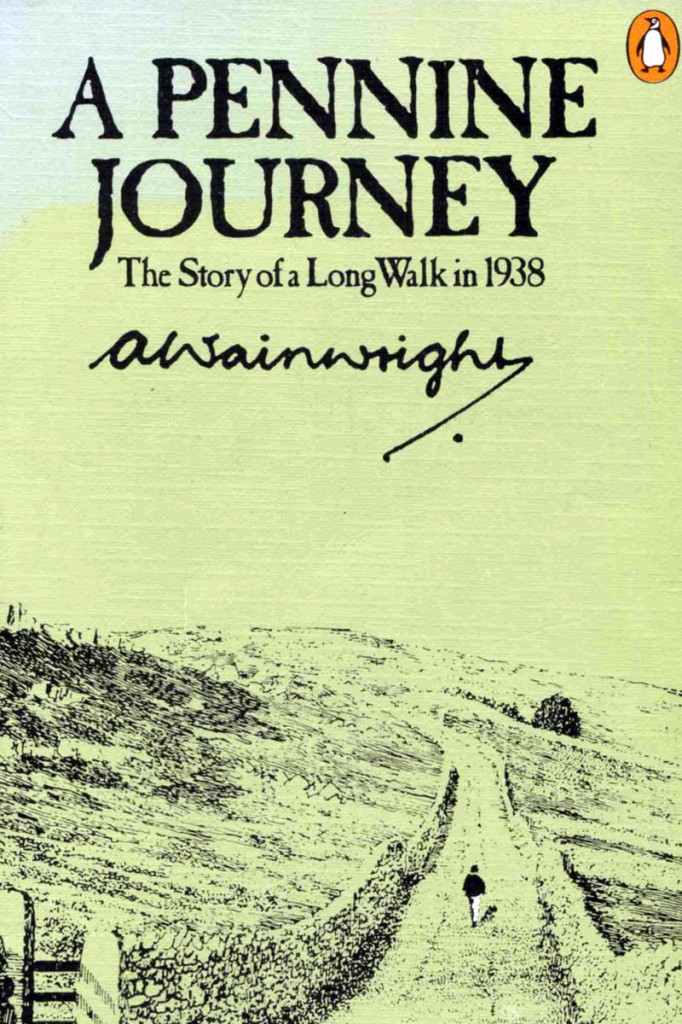
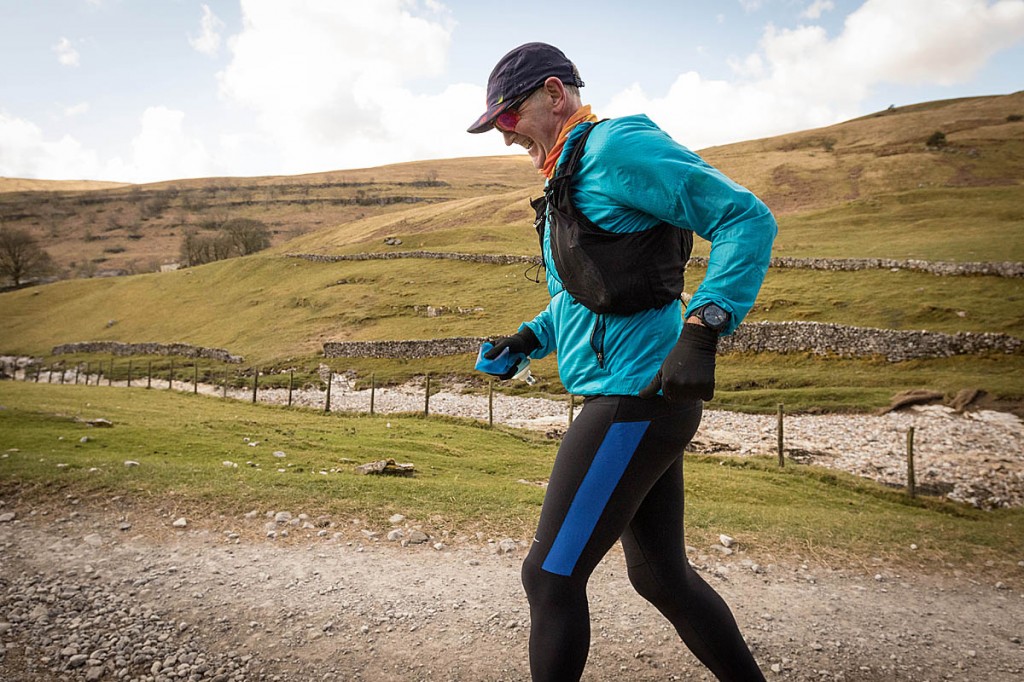
Alison Precious
25 June 2021Hi Bob - I felt that I must write a comment after I'd read yr wonderful article on Brian's run
As Brian's mum I am so PROUND of his achievement. Proud of him and his very supportive family. Thank. goodness that Susan inspired him and that Richard also did so much
A wonderful achievement in those bad conditions - my only regret was not to be up there as well